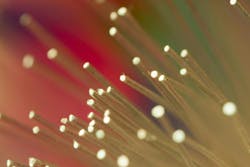Fiber’s forward future
By Gary Bolton / Fiber Broadband Association
The Southern Cross Cable system was commissioned in 2000. Spanning 18,000 miles between Australia, New Zealand, Hawaii, and California, the submarine cable network is the largest single run in the world. When first commissioned, the cables delivered 2.5 Gbps wavelengths, the state of the art at the time.
Twenty-five years and a few electronics upgrades along the way, Southern Cross now delivers a whopping 1 Tbps per wavelength in 2025, a fantastic feat of engineering and a testament to the long-term value of fiber. Similar announcements this year, highlighting the continued strength and utility of fiber, have come from around the world, with Telxius getting 1.3 Tbps out of its 4,100-mile cable between Virginia Beach, Virginia, and Bilbao, Spain, and the Hawaiki Transpacific Cable delivering 1.2 Tbps across a 2,700-mile segment under the Pacific.
These production announcements are merely the tip of the iceberg for increasing broadband speeds and capacity around the globe. In April of this year, Ciena, HyperLight Corporation, and McGill University demonstrated intra-data center links of 3.2 Tbps across 2-kilometer distances. With the Tbps era well underway, equipment manufacturers have described a roadmap to move existing networks from 100/400 Gbps to multiples of 800 Gbps as needed to support AI and the continued growth of data centers, both for building applications and delivering them to end users.
Last-mile evolution
Over the next decade, last-mile access networks will continue to be upgraded as well, with 25G PON-ready equipment already making up anywhere from anywhere from 25% to 30% of shipping ports. Some service providers are already entertaining the notion of installing 25G PON over XGS-PON from day one of a customer turn-up, as ONT prices inevitably come down, spending a little more money in hardware up front to forgo a future truck roll.
The increasing popularity of 25G PON is due to several factors. It enables service providers to deliver true 10G PON speeds for those customers who desire it. In the cellular space, 25G PON provides sufficient speed and flexibility to support 5G microcells in urban environments. Finally, carriers typically have three wavelength sets available, so they can run GPON, XGS-PON, and 25G PON over the same fiber without disrupting service or otherwise engaging in major engineering.
In the future, service providers will simply be able to retire the oldest generation of PON and roll in the newest generation. Moving to 50G PON will be more expensive, as it requires different electronics and optics for implementation, but 11 carriers around the world have already given the technology a workout on their networks without significant issues. Discussions are already underway at the ITU for standardizing speeds beyond 50G PON, with speeds of 100G and 200G on the table, with Nokia Bell Labs bold enough to suggest pushing the edge of possibility to 400G PON using dual wavelengths in combination with dual polarization.
All these speed advances use existing fiber, with little suggestion that we’re approaching the end of the line for the medium through the simple expedient of upgrading the electronics rather than changing the structure or type of glass used. But there is already plenty of research taking place examining the ways and costs for improving the medium of single-mode fiber to better and faster technology if we need to do so, but at the necessity to pull new cabling with the chosen next-generation fiber.
Hollow core fiber (HCF) shows potential
Hollow core fiber (HCF), a type of optical fiber that guides light through a hollow central core instead of today’s solid glass core, looks especially promising for specific applications today where lower latency, reduced signal loss, and increased speed are desired for an additional boost. Because the core is hollow, light passes through air or vacuum rather than solid glass, which reduces signal loss and latency. In addition, the use of hollow core can open up additional light spectrum for use, providing more sheer bandwidth for more data.
Last year, Microsoft announced it was working with hollow core fiber to speed up its Azure cloud infrastructure, noting that it delivers 47% faster speed than standard glass. HCF could either be used to transmit more data between two points of the network in two-thirds of the time, or could be used by extending the transmission distance in a network by up to 1.5 times with no impact on network performance.
Migrating to HCF isn’t going to happen anytime soon, because it will take time to move from R&D and small-scale production into scaling up to producing millions of miles per year. Technicians will have to be trained on splicing the new media, and we’ll have to discover the inevitable new quirks it brings to the table over our 40-year-old single-mode fiber. But you will hear more about HCF in the future for specialized applications to speed up AI data center networks and other places where latency makes a difference, and businesses are willing to pay for sheer speed.
But there are other options on the table to go beyond single-mode fiber. Japan’s National Institute of Information and Communications Technology (NICT) recently demonstrated a speed of 1.2 petabits per second over a distance of nearly 1200 miles, publishing their results at the OFC2025 conference in April of this year.
This feat was accomplished using a Sumitomo newly developed 19-core optical fiber that packed the cores into the same 0.125 mm diameter as a single-mode fiber. The progress is all the more amazing since fiber developer Sumitomo Electric started working with multi-core fibers within the last few years, announcing a demonstration 4-core fiber in 2021, making 2-core fiber available for commercial purchase in 2023, and first showing its 19-core fiber in 2023.
Standard single-core single-mode optical fiber has a capacity limit of only 250 Tbps. NICT researchers designed and built a demonstration transmission system that could amplify signals of the 19 cores simultaneously and compensate for interference between the cores using DSPs. I’m sure the discussion of how you splice and connect a 19-core fiber alone would make for an interesting Ted Talk!
But single-core optical fiber isn’t going anywhere. The cost of producing it in mass quantities has been refined for decades and there’s no slowing of demand for the material. At the same time, innovation continues to pack more fiber into the same or smaller diameter tube and to enhance the ability for bending fibers without damaging or breaking them so they can go to more places and deliver still more capacity through denser packaging.
Fiber’s future is exceptionally bright today and even more so tomorrow. Suppose 25-year-old fiber running thousands of miles under the sea can be steadily upgraded from 2.5 Gbps to 1 Tbps speeds without needing to be replaced and today’s GPON and XGS-PON services are being shifted to 25G PON speeds.
In that case, there’s plenty of forward room for improvement for decades to come without breaking the bank or having to retool with new media and dramatically different equipment in the central office or at the customer premises.
Gary Bolton is the CEO of the Fiber Broadband Association.

